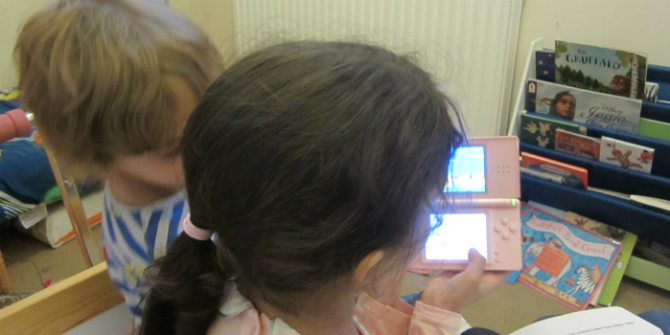 Connected learning has been defined as learning that is “socially embedded, interest driven and orientated towards educational, economic, or political opportunity”. In this post Sonia Livingstone outlines research from Parenting for a Digital Future, presented at the Connected Learning Summit in Cambridge, Massachusetts, which shows the many ways in which social class inequalities differentiate how parents can provide for their children’s informal learning. Sonia Livingstone is Professor of Social Psychology in the Department of Media and Communications at the London School of Economics and Political Science. [Header image credit: M. Stewart, CC BY-SA 2.0.jpg]
Connected learning has been defined as learning that is “socially embedded, interest driven and orientated towards educational, economic, or political opportunity”. In this post Sonia Livingstone outlines research from Parenting for a Digital Future, presented at the Connected Learning Summit in Cambridge, Massachusetts, which shows the many ways in which social class inequalities differentiate how parents can provide for their children’s informal learning. Sonia Livingstone is Professor of Social Psychology in the Department of Media and Communications at the London School of Economics and Political Science. [Header image credit: M. Stewart, CC BY-SA 2.0.jpg]
This year’s Connected Learning Summit, held at MIT’s Media Lab in Cambridge, Mass., attracted some 650 researchers, youth workers, educators, techies, librarians, game designers, makers and students to ask what’s new and significant in the theory, evidence, design and practice of ‘connected learning’. By this, Mimi Ito and colleagues emphasise learning that is “socially embedded, interest-driven, and oriented towards educational, economic, or political opportunity,” hypothesising that:
“Connected learning is realised when a young person is able to pursue a personal interest or passion with the support of friends and caring adults, and is in turn able to link this learning and interest to academic achievement, career success or civic engagement.”
Of particular interest to many in the digital age is whether and how the specific affordances of digital technologies can be used to enhance children and young people’s learning in this way. We can unpack this into two pressing but demanding kinds of question:
- If digital learning sites and activities are well-designed, can they stimulate and support young people’s interests, map out learning pathways, enable collaborative learning and peer support, and link young people’s activities with needed forms of expertise and mentoring? In other words, can they revitalise, refashion, or provide an alternative to some of those traditional forms of learning that have become too instrumental, competitive, individualised?
- Who will, and who should, benefit? Given the widespread appeal of digital technologies to young people of all social class backgrounds, can connected learning opportunities be promoted without further advantaging the already advantaged but, instead, by carefully targeting digital learning resources to benefit those who need it most?
With guiding questions like these, a lot of attention at the Connected Learning Summit focused on young people, educators, policy-makers and technology designers. But where do parents fit into this picture? Concerned that they easily get forgotten in discussions of connected learning, and building on our project, Parenting for a Digital Future, I presented two papers, co-authored with Alicia Blum-Ross.
Our findings
The first drew on our qualitative research with London parents. This reveals many ways in which social class inequalities differentiate how parents can provide for their children’s informal learning at home. This is hardly surprising, given long-term lack of social mobility in the UK. But it’s disheartening to see how digital technologies contribute to the social reproduction of dis/advantage more than they undermine it.
We also found that parents cannot be pigeonholed in binary terms as either middle class or working class. Many of the poor families we met were from ethnic minorities or migrant families, often using digital technologies to sustain diasporic or religious subcultures. Some had very little income but high levels of education, perhaps attracted by the opportunities of creative and alternative lifestyles and forms of work possible in the global city. Some were so wealthy they might merit another class category altogether.
However, whatever their income and education, most parents we interviewed are striving to support their children’s learning at home. And most are seizing on the potential of digital technology with an enthusiasm that is surely different from – and more inclusive than – previous generations’ turn to books, museums or libraries. We found a lot of dated, slow or even broken technology in the low-income homes we visited, along with some bemused or inexpert parents. However, we want to recognise and value the considerable efforts and investment that many poorer parents make. We also think it matters that they often place considerable faith in their children’s tech skills and ‘digital future‘, whether or not this comes to fruition as hoped.
Digital technologies re-inscribing inequalities?
While class categories may be complicated, especially as lived in the messy realities of family lives, our survey findings presented in our second paper at the Connected Learning Summit showed that:
- There are few differences by socio-economic status for the amount parents and children used the internet, but there are considerable differences in the range of devices they used and in their digital skills. The importance of inequalities in skills is perhaps more obvious than that of access to a range of devices – the latter hints at the benefits of personalised, flexible control over devices.
- As well as differences across families, there are also some meaningful similarities. Notably, parents often watch television and films with their children, as a key part of family activities, and this turn to digital media for shared positive experiences should be recognised. But some of their other uses of technologies (playing computer games together, contacting relatives and friends via Skype or similar, and using technology for creative activities) are again more common among middle class families.
- Less surprising, but also problematic, is the finding that middle class parents more often use the internet to support their children’s learning (and, indeed, their own). This has serious implications for the role of digital technologies in supporting connected learning.
Measuring connected learning is far from easy, as we discovered in designing our survey. However, we asked parents whether they thought that:
- Their child’s teachers value what they learn at home
- Their child’s teachers value what they learn in extracurricular activities
- They are well informed about what their child learns at nursery/school/college
- What their child learns at nursery/school/college connects with their family activities at home
As we will document in an upcoming report, middle class parents are more likely to agree with all of the above. So the problem remains: insofar as connected learning is facilitated by parents’ helping their children to follow their interests across different learning sites, it may be failing to promote the social justice goals its advocates have hoped for.
To end on a positive note, the Connected Learning Alliance is developing new ideas about how to redesign learning environments – formal and nonformal, offline and online, home and elsewhere – to better support collaborative, connected and creative learning in equity-respecting ways.
This post gives the views of the authors and does not represent the position of the LSE Parenting for a Digital Future blog, nor of the London School of Economics and Political Science.





